Situated at the southern tip of Anglesey and overlooking Bae Caernarfon, Llanddwyn Beach and island near the village of Newborough is an important photographic location. This area is home to the Twr Mawr lighthouse – a classic UK landscape photograph. You will also enjoy endless beaches, rocky pools, sand dunes and pine trees, views of Snowdonia and breathtaking sunsets. It’s a place that you could visit for sunrise and stay until sunset.
How To Get Here
If starting from Bangor it is a 13 mile drive (40 minutes) to Llanddwyn Beach. From Bangor cross the Britannia Bridge (A55) and turn left (exit 8A). Follow the A5 for half-a-mile to a left turn down Brynsiencyn Road/A4080 signposted Newborough (9 miles). Once in Newborough turn left down Church Street signposted Llys Rhosyr (opposite the post of ce). In 2 miles this road leads you through Newborough Forest to the extensive parking area at Llanddwyn Beach.
Note: if you are planning a sunrise or sunset shoot of Twr Mawr lighthouse allow 40 minutes to walk (1.5 miles) from the car park at Llanddwyn beach/Newborough Forest to get to Llanddwyn island.
Parking
- Parking Lat/Long: 53.144673, -4.385262
- Parking Postcode: LL61 6SG
- OS Map grid ref: SH 405 634
- Map: OS Explorer 263 Anglesey East
What To Shoot and Viewpoints
There is so much scenery and photographic subjects, including wildlife, on offer at this location that you’ll find yourself confronted by endless possible compositions. This location is divided into two main areas; Llanddwyn Beach and Llanddwyn Island, each with multiple viewpoints.
- Sunset reflections in pools left by the outgoing tide. Konica Minolta A200 at 29mm eq., 1/30 sec @ f/5.6, ISO 50. © Simon Kitchin
- Anglesey’s iconic view – February sunset at Tyr Mawr lighthouse. Samsung GX10, Sigma 17-70 at 19mm, 1/6 sec @ f/16, ISO 200, tripod. © Simon Kitchin
- Shooting low and wide emphasises the rippled sand. Konica Minolta A200 at 29mm eq., 1/125 sec @ f/5.6, ISO 50. © Simon Kitchin
Llanddwyn Beach
At the lower end of the car park take the path or raised walkway to the beach. If the tide is relatively low, you’ll see large pools of sea water left behind by the receding tide, useful foreground subjects for wide-angled compositions of the distant Snowdonia Mountains and Llŷn Peninsula. When calm these are good reflecting pools. The rippled sand is is often peppered with small pebbles and shells; all great close-up subjects. There is lots to explore at the water’s edge as well as the line of sand dunes and the Corsican and Scots pine forest which border the beach along this entire eastern section.
Abermenai Point
If you turn left out of the car park and continue east the closer you come to the Menai Strait, eventually reaching Abermenai Point with its fantastic views of the Llŷn Peninsula coastline. This is all the more special in the subdued light of the late evening sun. Take care on the beach here, tides approach quickly.
Llanddwyn Island
Llanddwyn Island is home to the 1873 built Twr Mawr lighthouse, a UK classic landscape photograph. Llanddwyn Island is a tidal island and juts out into the sea at the north west end of Llanddwyn Beach forming Llanddwyn Bay. The island is cut off at the highest tides.
To get here, turn right from the car park and walk toward the island. It takes 30 minutes along the beach to get to Twr Mawr – a mile and a half walk. Once at the island there are a choice of paths: a main gravelled path and a network of smaller paths. All are worth exploring, all leading to the lighthouse. Twr Mawr is perfect as the centrepiece of a composition to include the distant Llŷn Peninsula coastline. This is a classic wide-angle composition usually taken from the small hill just 200 meters inland to the north of the lighthouse; easily identified by the stone cross on its summit. There are many other compositions of the lighthouse to discover.
There is much to photograph here, including the ruins of St. Dwynwen’s Church. Llanddwyn means the Church of St. Dwynwen. Dwynwen was the daughter of the 5th century King Brychan Brycheiniog. She fell in love with a young man named Maelon but he was turned into ice by an angel. Dwynwen then became a hermit on Llanddwyn Island until her death. She is the Welsh patron saint of lovers and her saints day on the 25th of January is the Welsh equivalent of St. Valentines day.
Look out for ornate wooden gates and benches, the white-washed pilots cottages and celtic crosses. If you are lucky there will be Welsh ponies in residence and there are rocky coves and small islands to explore.
- A seat with a view. Nikon D800, 16-35 at 21mm, 1/180 sec @ f/100, ISO 100. © Simon Kitchin
- Welsh Mountain Ponies roaming Llanddwyn Island. Nikon D800, 70-300VR at 200mm, 1/1000 sec @ f/5.6, ISO 800. © Simon Kitchin
- Pines of Newborough Forest tower above the sandy beach. Nikon D800, 24-120 at 28mm, 1/180 sec @ F/11, ISO 100. © Simon Kitchin
Wildlife
Red squirrels were reintroduced to Newborough Forest in 2004 and they are now thriving amongst the stands of Corsican pines. Anglesey now contains the largest population of red squirrels in Wales, with many migrating over to the mainland. Ravens roost here in large numbers, up to 2,000 of these birds have been counted in the dunes at Newborough, although recently the numbers have dropped to around 800. The area is a bird photographers paradise. Birds common to the dunes include herring gulls, oystercatchers, lapwings, curlew, skylarks and meadow pipits. The dunes are also home to toads and lizards.


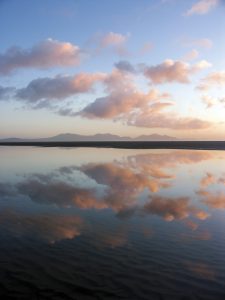
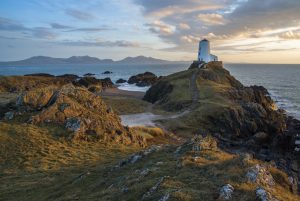
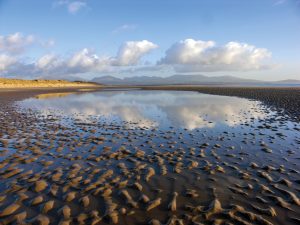
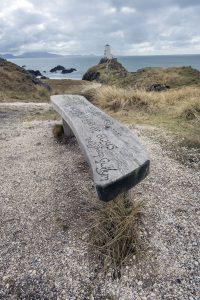
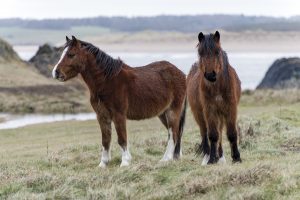

Rob Powell
Is this a nice romantic to propose ?